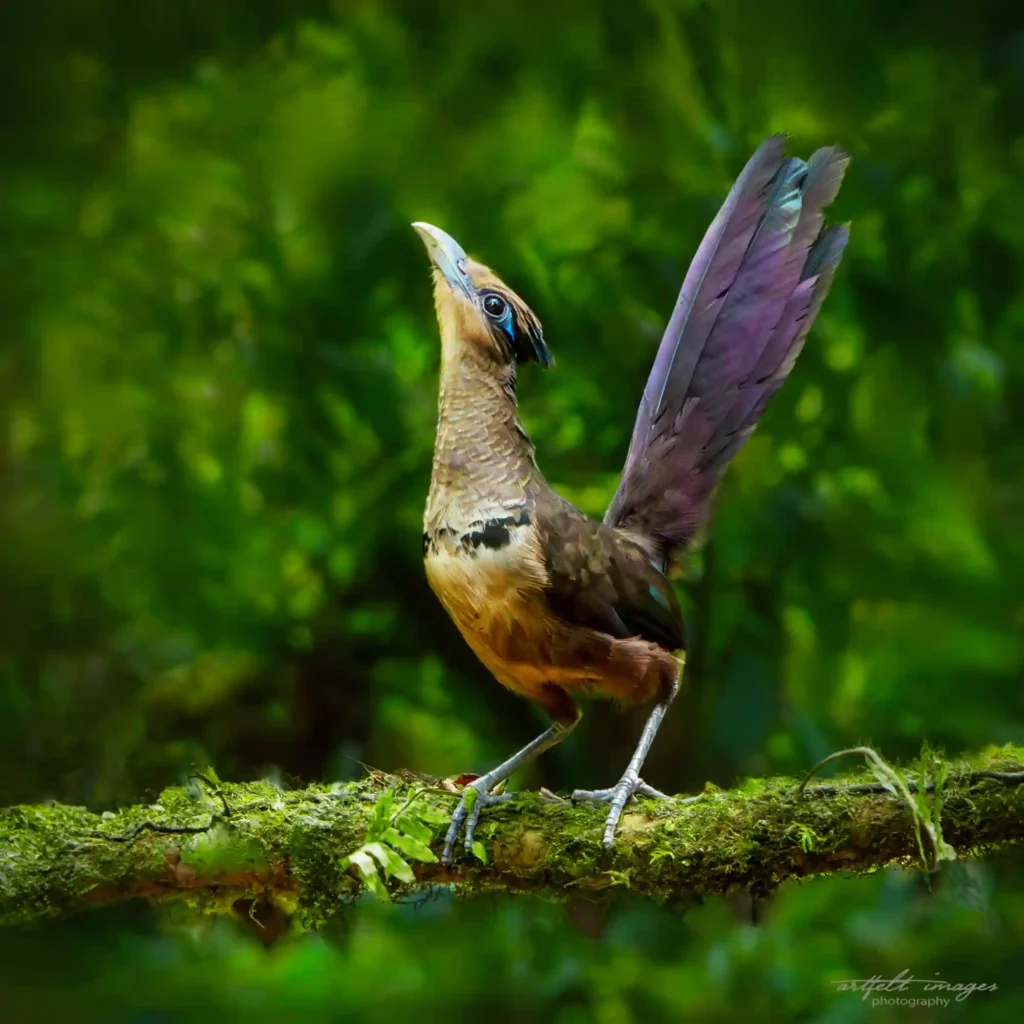Rufous-vented Ground Cuckoo
The Rufous-vented Ground Cuckoo is a rare and elusive bird of the Neotropical rainforests. Known for its terrestrial habits and secretive nature, this species is a coveted sighting among birdwatchers. In Costa Rica, it inhabits the dense, humid forests of the Caribbean slope, where it often follows army ant swarms to feed on disturbed prey.

Neomorphus geoffroyi
Scientific Name
Cuculidae (Cuckoos)
Family
Cuculiformes
Order
Six recognized subspecies, including N. g. salvini
Subspecies. Central America, including Costa Rica
Range and Habitat of Rufous-vented Ground Cuckoo
Geographic Range
This species ranges from southern Nicaragua through Costa Rica and Panama, extending into northwestern Colombia and parts of the Amazon basin.
Migratory Patterns
The Rufous-vented Ground Cuckoo is non-migratory, residing year-round within its range.
Preferred Habitat
Prefers mature, undisturbed evergreen forests, often in lowland and foothill regions. It is typically found in areas with dense understory vegetation.
Altitude Range
In Central America, it ranges from sea level up to 1,450 meters.
Costa Rica Habitat
In Costa Rica, the Rufous-vented Ground Cuckoo is found primarily on the Caribbean slope, including the wet forests of Limón Province and the northern regions of Guanacaste. Notable locations include La Selva Biological Station and Braulio Carrillo National Park.
Conservation Status
Vulnerable
Conservation Status
Population Status
The global population is estimated between 63,000 and 127,000 mature individuals and is believed to be decreasing
Habitat loss due to deforestation and fragmentation is the primary threat, as the species requires large tracts of undisturbed forest.
Conservation efforts
The Rufous-vented Ground Cuckoo is found in several protected areas throughout its range, including multiple sites in Costa Rica.
Primary Threats
Habitat loss due to deforestation and fragmentation is the primary threat, as the species requires large tracts of undisturbed forest.
Rufous-vented Ground Cuckoo Identification
How to Identify the Species
Rarity Level:
CommonBest Viewing Times:
Midday (11 AM - 2 PM), Afternoon (2 PM - 5 PM)
Size
Length: Approximately 45–51 cm (17.7–20 inches) Weight: Around 300–350 grams
Plumage
Generally brownish upperparts with variations among subspecies. The underparts are pale or buffy with a prominent black band across the lower breast and rufous-colored vent.
Distinctive Features
Features a shaggy, glossy blue-black crest, bright blue skin surrounding the eye, and a heavy decurved bill that is pale grayish-green to horn-colored with a yellow tip.
Sexual Dimorphism
Males and females have similar plumage; no significant sexual dimorphism observed.
Diet and Feeding Behavior
Primary Diet
- Feeds on large insects, arthropods, small vertebrates like lizards and amphibians, and occasionally fallen fruits.
Foraging Techniques
- Often follows army ant swarms, peccaries, and monkey troops to catch prey fleeing from them.
Feeding Times
- Primarily diurnal; most active during daylight hours.
Behavior Patterns
Rufous-vented Ground Cuckoo
Social Structure
Typically solitary or found in pairs; not known to form large groups.
Song and Vocalization
The principal vocalization is a low, drawn-out moaning coo: “oooooooooooooooop.” At army ant swarms, it emits a muffled, barking “woof” call and a sharp, loud “kchak!” call.
Courtship and Mating Ritual
Breeding seasons vary by region; in Central America, nesting occurs during the northern summer.
Territoriality
Specific territorial behaviors are not well-documented; however, the species is generally elusive and maintains a low profile within its habitat.
Birdwatching Tips
Best Locations for Spotting Rufous-vented Ground Cuckoo
In Costa Rica, prime locations include San Ramon, Arenal, La Selva Biological Station, Braulio Carrillo National Park, and the Pocosol Research Station.

Best Time of the Year
Year-round, with increased chances during the dry season (December to April) when army ant swarms are more active.
Common Behavior
Look for individuals following army ant swarms on the forest floor; they may also be observed near groups of peccaries or monkeys.
Recommended Gear
Binoculars with excellent low-light performance, a camera with a fast shutter speed, and a field guide for identification.
Breeding and Nesting Behavior
Breeding Season
During the northern summer
Nesting Sites
Nests are built in tree forks 2–5 meters above the ground, constructed from large sticks and lined with dry grass and fresh leaves.
Clutch Size
Typically, a single egg is laid
Incubation Period
Parental Care
Both parents are believed to participate in incubation.